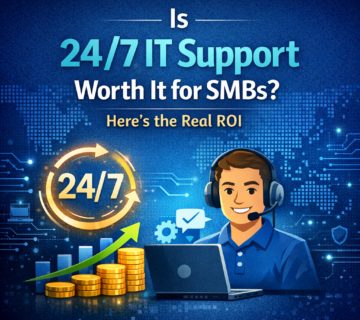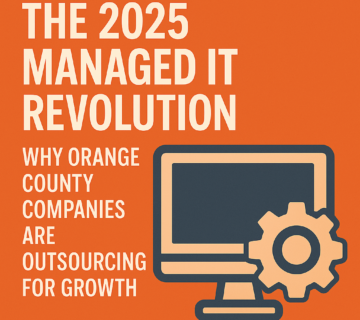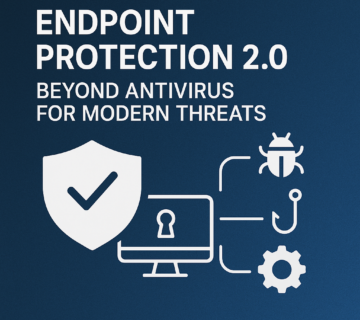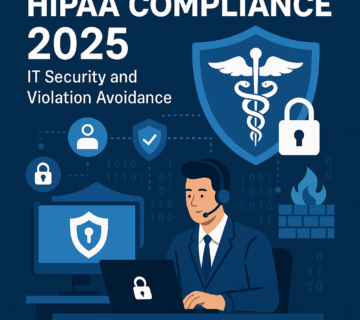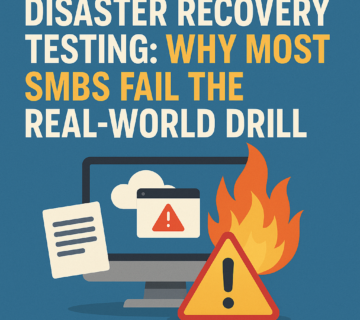Cybersecurity for Small Businesses: The 2025 Ransomware Defense Playbook
🎙️ Dive Deeper with Our Podcast!
Ransomware Defense Strategy for Small Business Resilience
The ransomware landscape has evolved dramatically, and small businesses are increasingly finding themselves in the crosshairs. In 2025, cybercriminals are deploying more sophisticated attacks than ever before, targeting companies that often lack the robust defenses of larger enterprises. For small businesses in Orange County and across Southern California, understanding modern ransomware tactics and implementing a comprehensive defense strategy isn’t just recommended—it’s essential for survival.
The Evolving Ransomware Threat Landscape
Attacks using ransomware are now more costly, disruptive, and targeted. Cybercriminals no longer simply encrypt files and demand payment; they now exfiltrate sensitive data before encryption, threatening to publish confidential information if ransoms aren’t paid. This double-extortion tactic has proven devastatingly effective against small businesses that may not have robust backup systems or incident response plans.
Recent trends show that attackers are specifically targeting companies with 50-250 employees—organizations large enough to pay significant ransoms but small enough to potentially lack enterprise-grade security. The average ransom demand has increased substantially, with some small businesses facing demands exceeding six figures. Beyond the ransom itself, the true cost includes operational downtime, regulatory fines, legal expenses, and long-term reputational damage.
How Modern Ransomware Attacks Unfold
Understanding how attackers operate is the first step in building effective defenses. Modern ransomware campaigns typically follow a multi-stage approach that can span days or even weeks before the actual encryption occurs.
Initial Access and Reconnaissance
Attackers gain entry through various vectors including phishing emails with malicious attachments, compromised credentials purchased on dark web marketplaces, unpatched software vulnerabilities, or through legitimate remote access tools. Once inside your network, they don’t immediately deploy ransomware. Instead, they spend time mapping your infrastructure, identifying critical systems, locating backup repositories, and escalating their privileges to gain administrator access.
Lateral Movement and Persistence
After establishing their foothold, cybercriminals move laterally across your network, compromising additional systems and creating multiple backdoors to maintain access even if one entry point is discovered. They specifically target backup systems, domain controllers, and other critical infrastructure that would be necessary for recovery.
Data Exfiltration and Encryption
Before triggering the encryption payload, attackers exfiltrate sensitive data including customer records, financial information, proprietary business data, and employee personal information. Only after securing this leverage do they deploy the ransomware, often timing the attack for weekends or holidays when IT staff may be unavailable to respond quickly.
The Essential Components of Ransomware Protection in 2025
Defending against sophisticated ransomware requires a layered security approach. No single technology can provide complete protection, which is why cybersecurity for small business environments must incorporate multiple defensive layers that work together to detect, prevent, and respond to threats.
Endpoint Detection and Response (EDR)
Modern endpoint security has evolved far beyond traditional antivirus software. Advanced EDR solutions use behavioral analysis and machine learning to identify suspicious activities before they escalate into full-blown attacks. These systems monitor endpoints in real-time, analyzing process behaviors, network connections, and file modifications to detect anomalous patterns indicative of ransomware.
Leading EDR platforms can automatically isolate compromised devices from the network, preventing lateral movement while allowing security teams to investigate and remediate the threat. For small businesses without dedicated security staff, managed EDR services provide this critical protection without requiring in-house expertise.
Next-Generation Antivirus and Threat Intelligence
Antivirus software based on signatures is no longer adequate to combat contemporary threats. Next-generation solutions incorporate threat intelligence feeds that provide real-time information about emerging attack campaigns, known malicious infrastructure, and evolving tactics used by ransomware operators. This intelligence allows security systems to proactively block threats before they reach your environment.
Security Operations Center (SOC) Monitoring
Continuous monitoring by experienced security analysts provides the human intelligence that automated systems alone cannot deliver. A SOC team watches for indicators of compromise, correlates events across your infrastructure, and responds to threats 24/7. For small businesses, partnering with a managed security services provider makes enterprise-grade SOC capabilities accessible without the prohibitive cost of building an in-house security operations team.
Identity and Access Management
Many ransomware attacks exploit weak or compromised credentials. Implementing multi-factor authentication across all systems, enforcing strong password policies, and applying least-privilege access principles significantly reduces your attack surface. Regular access reviews ensure that former employees and contractors no longer have network access that could be exploited.
Network Segmentation and Micro-Segmentation
Dividing your network into isolated segments limits how far attackers can spread if they gain initial access. Critical systems should be separated from general user workstations, and sensitive data repositories should require additional authentication to access. This containment strategy prevents ransomware from moving freely across your entire infrastructure.
Building Your Ransomware Defense Stack
Creating an effective defense requires integrating multiple security technologies into a cohesive architecture. The most successful approaches combine prevention, detection, and response capabilities.
Microsoft Defender: Foundation-Level Protection
For organizations using Microsoft 365 and Windows environments, Microsoft Defender provides robust baseline security. Defender for Endpoint offers real-time protection against malware and ransomware, with built-in behavioral monitoring and automated investigation capabilities. When properly configured and managed, Defender serves as an excellent foundation for small business cybersecurity.
However, Defender alone may not provide sufficient protection against advanced persistent threats. Its effectiveness depends heavily on proper configuration, regular policy updates, and integration with broader security monitoring systems.
Advanced Threat Detection with CrowdStrike
Organizations requiring enhanced endpoint security often layer CrowdStrike Falcon on top of or alongside their existing protections. CrowdStrike’s cloud-native platform provides industry-leading threat detection powered by continuous threat intelligence gathered from protecting millions of endpoints worldwide. Its lightweight agent delivers powerful protection without impacting system performance.
CrowdStrike excels at detecting sophisticated attacks, including fileless malware, living-off-the-land techniques, and zero-day exploits that traditional security tools might miss. The platform’s threat hunting capabilities allow security teams to proactively search for indicators of compromise before they escalate into incidents.
Managed SOC Services: The Human Element
Even the most advanced security technologies require skilled analysts to interpret alerts, investigate anomalies, and coordinate responses. Managed SOC services provide expert monitoring and threat response, typically including 24/7 alert triage, threat hunting, incident investigation, and coordinated response when breaches occur.
For small businesses, outsourcing SOC functions to experienced providers delivers enterprise-level security expertise at a fraction of the cost of building internal capabilities. This approach ensures that security events receive immediate attention from professionals who specialize in threat detection and response.
Critical Backup and Recovery Strategies
Even with robust prevention and detection, maintaining comprehensive backups remains essential. The 3-2-1 backup rule provides a solid framework: maintain at least three copies of your data, stored on two different types of media, with one copy kept offsite or offline.
Immutable Backups
Ransomware operators specifically target backup systems, knowing that destroyed backups force victims to consider paying ransoms. Immutable backups cannot be encrypted, modified, or deleted for a specified retention period, ensuring that you maintain clean recovery points even if attackers compromise your backup infrastructure.
Air-Gapped Storage
Maintaining offline backup copies that are physically or logically disconnected from your network provides the ultimate protection against ransomware encryption. These air-gapped backups should be tested regularly to ensure they can be restored when needed.
Recovery Time Objectives
Understanding how quickly you need to restore operations determines your backup frequency and technology choices. Critical systems may require continuous replication to minimize potential downtime, while less critical data might use daily or weekly backup schedules.
Employee Training and Security Awareness
Technology alone cannot prevent all ransomware attacks. Human error remains the leading cause of security breaches, making comprehensive security awareness training essential for every organization.
Phishing Recognition
Employees should learn to identify suspicious emails, verify unexpected requests for sensitive information or wire transfers, recognize social engineering tactics, and understand proper procedures for reporting potential threats.
Safe Computing Practices
Training should emphasize the importance of keeping software updated, using strong unique passwords, avoiding public Wi-Fi for business activities, and being cautious about downloading files or clicking links.
Incident Reporting Procedures
Creating a culture where employees feel comfortable reporting potential security incidents without fear of punishment ensures that threats are identified and addressed quickly. Many breaches could have been prevented if suspicious activities had been reported immediately rather than ignored out of fear of criticism.
Regulatory Compliance and Cyber Insurance
Small businesses must also consider regulatory requirements and insurance implications when developing their cybersecurity strategies.
Industry-Specific Requirements
Healthcare organizations must comply with HIPAA security requirements, financial services companies face regulations from multiple agencies, and any business handling customer data should consider requirements under California’s CCPA and other data protection laws. Ransomware incidents often trigger notification requirements and potential regulatory penalties.
Cyber Insurance Considerations
Cyber insurance can help offset the financial impact of ransomware attacks, but insurers are increasingly requiring specific security controls before providing coverage. Common requirements include multi-factor authentication implementation, EDR deployment on all endpoints, regular security assessments, documented incident response plans, and immutable backup systems.
Incident Response Planning
Despite best efforts, breaches can still occur. In the event of a ransomware attack, having a documented incident response strategy guarantees that your team can respond promptly and efficiently.
Response Team and Roles
Your plan should clearly define who is responsible for various aspects of incident response, including technical containment, executive decision-making, legal counsel, public relations, and communication with affected parties.
Containment and Eradication
When ransomware is detected, immediate network isolation of affected systems prevents further spread. Identifying and removing attacker access points ensures they cannot simply re-deploy ransomware after initial remediation.
Recovery and Lessons Learned
After containing the incident, focus shifts to restoration from clean backups, verification that attacker access has been eliminated, and conducting post-incident analysis to identify how the breach occurred and what improvements should be implemented.
Frequently Asked Questions
How much does ransomware protection cost for a small business?
Comprehensive ransomware protection typically costs between $50-150 per user per month, depending on your organization’s size and complexity. This investment covers EDR tools, SOC monitoring, backup solutions, and managed services. While this may seem significant, the average ransomware recovery cost for small businesses exceeds $250,000 when accounting for downtime, remediation, and potential ransom payments—making proactive protection far more cost-effective than dealing with an actual attack.
Can’t we just restore from backups if we get hit with ransomware?
While backups are essential, modern ransomware attacks often involve data theft before encryption. Even if you successfully restore your systems, attackers may still threaten to publish stolen data unless you pay a ransom. Additionally, sophisticated attackers specifically target and encrypt or delete backups, making recovery impossible without proper immutable backup strategies. Backups are crucial but must be part of a comprehensive defense strategy rather than your only protection.
Do small businesses really need enterprise-grade security tools like CrowdStrike?
Small businesses are increasingly targeted precisely because cybercriminals believe they lack sophisticated defenses. Advanced threats don’t distinguish between large enterprises and small companies—attackers use the same sophisticated techniques against both. Managed security services make enterprise-grade tools accessible to smaller organizations at reasonable costs, providing protection proportionate to the threats you face.
How quickly can ransomware spread through our network?
Modern ransomware can propagate across an entire network within hours or even minutes once triggered. However, attackers typically maintain hidden access for days or weeks before deploying the encryption payload, using this time to identify critical systems and disable backups. This makes early detection through continuous monitoring absolutely critical—by the time you notice obvious symptoms, significant damage may already be underway.
What should we do immediately if we suspect a ransomware attack?
If you suspect ransomware activity, immediately disconnect affected systems from the network but don’t power them down, as this may destroy forensic evidence. Alert your IT team or managed service provider immediately, preserve any evidence of the attack, avoid paying ransoms without consulting security and legal experts, and begin following your incident response plan. Quick action can limit damage, but decisions about payment, communication, and recovery should be made strategically with proper expert guidance.
Is paying the ransom ever the right choice?
Law enforcement and cybersecurity experts strongly discourage paying ransoms. Payment doesn’t guarantee you’ll receive decryption keys, funding cybercriminal operations encourages future attacks, and many ransomware operators deploy multiple malware strains that allow them to attack you again later. Some organizations in desperate situations have chosen to pay, but this should only be considered as an absolute last resort after exhausting all other recovery options and consulting with legal counsel and security experts.
How often should we test our backup and recovery procedures?
You should conduct backup restoration tests at least quarterly for critical systems and annually for all other systems. These tests verify that your backups are actually working, restoration procedures are documented and effective, and recovery time objectives can be met. Many organizations discover their backups are corrupted or incomplete only when they desperately need them during an actual incident.
How Technijian Can Help Protect Your Business
Defending against ransomware requires expertise, advanced tools, and constant vigilance that most small businesses cannot maintain in-house. That’s where Technijian’s comprehensive cybersecurity services make the difference between vulnerability and resilience.
Technijian deploys layered defense strategies combining Microsoft Defender, CrowdStrike Falcon, and 24/7 SOC monitoring to provide enterprise-grade protection tailored for small and medium-sized businesses. Our security experts design customized defense architectures that address your specific risk profile, industry requirements, and budget constraints.
Our ransomware protection services include continuous network and endpoint monitoring to detect threats before they escalate, managed EDR implementation and ongoing optimization, immutable backup solutions with verified recovery procedures, employee security awareness training programs, incident response planning and coordination, and regular security assessments to identify and remediate vulnerabilities.
Don’t wait until ransomware brings your operations to a halt. Take the first step toward comprehensive protection by requesting a complimentary cybersecurity vulnerability scan from Technijian. Our assessment will identify security gaps in your current environment and provide actionable recommendations to strengthen your defenses against ransomware and other cyber threats.
About Technijian
Since 2000, Technijian has been protecting businesses throughout Orange County and Southern California with comprehensive managed IT services and cybersecurity solutions. Founded by Ravi Jain and based in Irvine, California, Technijian serves diverse industries including healthcare, finance, legal, retail, and professional services. Our team of certified security professionals stays ahead of emerging threats, ensuring your business benefits from the latest defensive technologies and best practices. Whether you need complete security infrastructure implementation or want to enhance your existing protections, Technijian delivers the expertise and support that keeps your business secure, compliant, and operational. Contact us today to discuss your cybersecurity needs and discover how our proactive approach to threat protection can give you peace of mind in an increasingly dangerous digital landscape.
